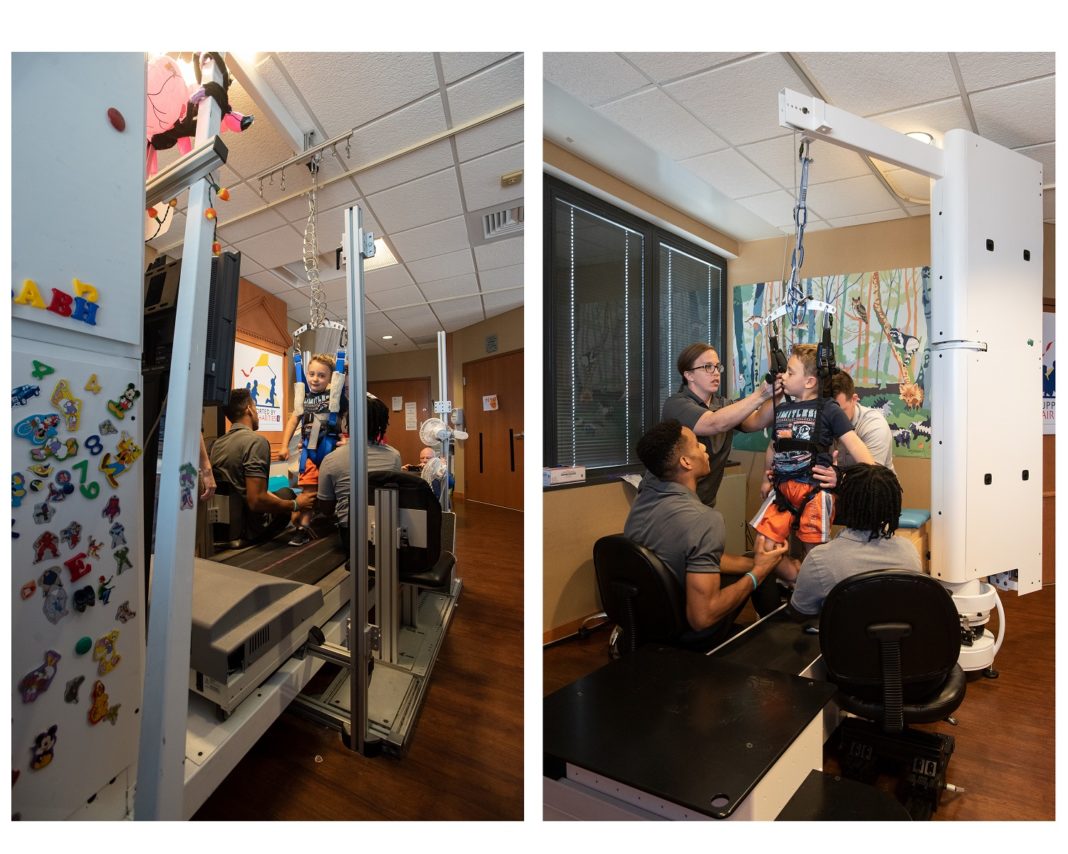
LOUISVILLE, Ky. – Children with spinal cord injuries have experienced remarkable results in recovery at the University of Louisville and Frazier Rehab Institute through locomotor training, a therapy designed to help them recover the ability to sit, stand and even walk. In locomotor training, the child is suspended over a treadmill and his or her feet are moved by trainers in a stepping motion. This taps into capability of the spinal cord to help the child regain movement and trunk control.
Andrea Behrman, Ph.D., of the UofL Department of Neurological Surgery and the Kentucky Spinal Cord Injury Research Center (KSCIRC), pioneered the use of locomotor training in children at UofL since 2012. Until now, however, Behrman’s team has used treadmills and harnesses designed for adults that have been adapted for children. The oversized equipment is cumbersome for children and working on cut-down adult-sized devices has resulted in unnecessary strain for the trainers and therapists who work with them.
So Behrman enlisted Tommy Roussel, Ph.D. of the Department of Bioengineering at UofL, to engineer a treadmill and harness system specifically for young children. Using engineering expertise, user feedback and a patent held by Susan Harkema, Ph.D., professor of neurosurgery and pioneer in spinal cord injury research in adults at UofL, a new treadmill was designed from the ground up just for children. [See video]
“It was kind of like putting a kid on an adult bicycle or watching kids play basketball with a ten-foot goal,” Roussel said. “So we have redesigned the system with the same operational capacity but with kids in mind.”
The new pediatric treadmill has multiple advantages for both children and trainers:
- Suspension tower is located behind the child on the treadmill so therapists can more easily and directly engage with the child
- Narrower tread, focusing the child’s steps and bringing trainers closer to the child’s legs and feet
- Trainers’ seats are more appropriately positioned closer to the child and are adjustable to accommodate trainers of different heights
- Treadmill tower swivels to allow the child to be hoisted from a wheelchair and onto the treadmill
- Smaller, more adaptable harness that is more comfortable and easier to adjust to the child’s changing capability
“The treadmill is a tool for us, but we want it to be a smart tool. By making it better, we are going to do our jobs better and the child is going to participate better,” Behrman said. “We changed it to make the child more accessible to the trainer with good body posture and position for all this repetitive activity.”
Thanks to funding and support from the Coulter Translational Partnership at UofL, the team was able to develop the initial prototype. Behrman and Roussel then collaborated with other specialized manufacturers, further refining the treadmill and harnesses. Once they had a customized treadmill, the team worked to commercialize the device and harness system to make it available to therapists in other centers.
“We starting thinking, ‘How can we make it better?’” Roussel said. “If we are going to move to manufacturing this, how can we make it more modular and with fewer parts that need to be assembled? That’s where the magic and the fun happened.”
The treadmill design was licensed to Power Neurorecovery and units are in place or on their way to facilities in Pittsburgh, Houston and New York, as well as in Louisville at Frazier Rehab Institute.
“In the last several years, we have been able to achieve things that have not historically happened in terms of rehabilitation outcomes for these children,” Behrman said. “Children once unable to sit on their own, for example, can now do so due to locomotor training. Such improvements open up other possibilities to play and engage, and help a child get back on the developmental track. This new treadmill system gives physical therapists and trainers a device that is state-of-the-art in design and utility and revolutionizes the way we deliver locomotor training specifically for children.”
#WeAreUofL
About Malcom MacIntyre:
When he was 14 months old, Malcom MacIntyre had a tumor removed from his spine that left him paralyzed from the chest down. Now 5 years old, he started locomotor training with the pediatric spinal cord injury specialists at UofL’s Kentucky Spinal Cord Injury Research Center (KSCIRC) and Frazier Rehab Institute in March, 2018.
Thank you to these donors and developers:
Treadmill Donors
- Christopher and Dana Reeve Foundation
- Kosair Charities
- WHAS Crusade for Children
- Independent Pilots Association Foundation
Treadmill Developers
- Ty Adams
- Jena Allen
- Laura Argetsinger
- Andrea Behrman
- Yangsheng Chen
- Ran Cheng
- Susan J. Harkema
- Dena Howland
- Winston Rauch
- Tommy Roussel
- Shelley Trimble
- Winston Industries
- Haffendorfer Machine Inc.
- Tuff Tread Treadmills
Harness Donors
- WHAS Crusade for Children
- Rich and Norrie Oelkers and the Bonita Bay Tennis Club
Harness Developers
- Jenna Allen
- Laura Argetsinger
- Andrea Behrman
- Goose Kearse
- Rachel Marsilia
- MacKenzie Roberts
- Misty Mountain Threadworks
























